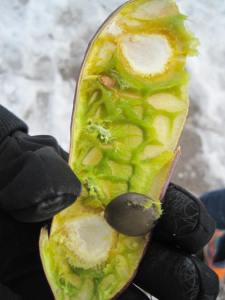Everyone likes coffee, don’t they? Well, you should! How about the Kentucky Coffee Tree? While you can’t get a latte from one, they are a pretty special deciduous tree. They are native to Southwestern Ontario, but sadly are also considered a species at risk by the Ontario Ministry of Natural Resources. These threatened trees are deserving of a little attention, so that more people do something to help increase their numbers.
Kentucky Coffee Trees are a medium to tall tree, grow approximately 15-25 metres high and live for 100-150 years. They have grayish-brown bark with deep fissures and plates which curl at their edges. The wood is a hard, heavy density with good durability, so appreciated by cabinet makers and carpenters.
 Kentucky Coffee Trees have the distinction of having the largest leaves of any tree in Canada; you won’t find anything bigger than their 60 by 90 cm leaves. Similar to honey locusts, they have bipinnately compound leaves, with 5-9 pairs of pinnae with the lowest leaves appearing as simple leaflets. The leaflets are ovate shaped with a pinkish hue in spring when they emerge in May/June, turning to green in summer and golden-yellow in the fall. As their leaves drop early, the Kentucky Coffee Tree has been nicknamed Chicot (Dead Tree) by French Canadians; an apt name for its barren look in winter. The latin name is Gymnocladus dioicus.
Kentucky Coffee Trees have the distinction of having the largest leaves of any tree in Canada; you won’t find anything bigger than their 60 by 90 cm leaves. Similar to honey locusts, they have bipinnately compound leaves, with 5-9 pairs of pinnae with the lowest leaves appearing as simple leaflets. The leaflets are ovate shaped with a pinkish hue in spring when they emerge in May/June, turning to green in summer and golden-yellow in the fall. As their leaves drop early, the Kentucky Coffee Tree has been nicknamed Chicot (Dead Tree) by French Canadians; an apt name for its barren look in winter. The latin name is Gymnocladus dioicus.
Greenish white flowers appear in June after the leaves emerge. They are dioecious, meaning trees are either male or female. This accounts for one of the reasons for its scarcity, as both a male and female tree need to be in close proximity to produce seeds. The hard brown seeds are found within a 15-25 cm long thick, slightly curled reddish-brown pod. It is also extremely difficult to break open, lending to more difficulty in natural propagation.
Kentucky Coffee Trees are shade intolerant trees that prefer moist rich soils. They are often found on floodplains, but can tolerate droughts, flooding, rocky or sandy soils. As they are quick-growing trees and fairly pest-free, they are a great choice for urban trees. It is important to note though that the leaves, seeds and pulp are considered toxic, so should not be planted near areas where livestock graze. Of course, some early settlers and Native Americans roasted the beans to eat or turn into a coffee-like beverage. Perhaps using the seeds in games would be a better alternative though.
If you are debating planting a tree or two, the Kentucky Coffee Tree should be one to consider. Make sure you find it from an ethical source and plant it in a location it will thrive. After that, enjoy this beautiful native tree for years to come.







Seriously, we all ❤ coffee, but never pay attention to the proper & tender care of the plant, so that it will grow at it best and will deliver the best result.
Thanks for sharing your tips & tricks with us.
Proper planting, care and upkeep are so important to the health of trees and yet so many people don’t know the first thing about how to go about it. That’s why we try to inform people – so that trees have a chance to survive and thrive!
Thanks for stopping by Treeys.